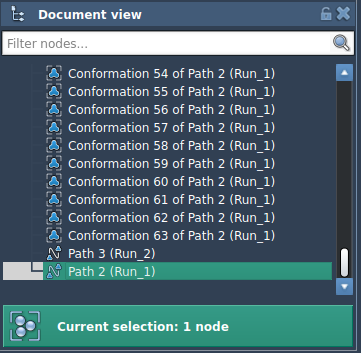For molecular modelers working with complex ligand-protein interactions, understanding unbinding processes often means exploring energy landscapes – and that usually includes optimizing transition paths. This is where SAMSON’s Parallel Nudged Elastic Band (P-NEB) app comes in. If you’ve generated unbinding paths using SAMSON’s Ligand Path Finder or similar tools, you can take the next step by refining these with P-NEB to obtain smoother, realistic minimum energy pathways.
Why optimize unbinding paths?
Simulated unbinding paths are critical for exploring how ligands exit binding pockets, and understanding mechanisms like induced fit or conformational selection. If your initial paths are interpolated or predicted but not energy-minimized, they may pass through unrealistic configurations. P-NEB refines these paths using a climbing image optimization method and can produce paths that follow a physically meaningful trajectory.
Getting started: from raw paths to refined transitions
SAMSON allows you to apply P-NEB directly to a path. For example, if you’ve already loaded an unbinding path for a Zinc ligand or the lactose permease TDG complex, you can jump right in:

Step-by-step:
- Open the P-NEB app via Home > Apps > All > P-NEB.
- In the Document view, select a path node corresponding to the unbinding trajectory.
- In the P-NEB app, configure your settings:
- Spring constant: 1.00
- Number of loops: 100
- Interaction model: Universal Force Field
- Optimizer: FIRE (Fast Inertial Relaxation Engine)
- Parallel execution: checked
- Climbing image method: optional (leave unchecked for faster runs)
- Suffix name: NEB
- Click Run. P-NEB will ask whether to use existing bonds—choose yes.
P-NEB computes in parallel (one thread per image/conformation), optimizing intermediate states to minimize their energy while keeping the trajectory realistic and continuous.

What do you get?
After the computation, you’ll find a new, optimized path in the Document view:

You can animate the path by double-clicking on it, inspect it frame by frame with the Inspector, or compare it to your initial trajectory. The goal is to identify smoother transitions and possibly more accurate saddle points between energy minima.
When should I use paths instead of conformations?
While P-NEB can also be applied to a series of conformations, applying it to a path is faster and easier. You can even convert a set of conformations into a path using the context menu: Conformation > Create path from conformations.
By integrating P-NEB into your workflow, you add a crucial refinement step to your simulations that could improve the predictive power of your ligand unbinding or conformational change studies.
To see it all in action and dive deeper into the settings and options, check the full tutorial here: Optimize transition paths with the Parallel Nudged Elastic Band method.
SAMSON and all SAMSON Extensions are free for non-commercial use. You can get SAMSON at https://www.samson-connect.net.





